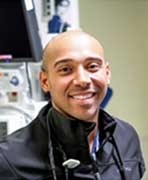Science
A study by the National Institute on Drug Abuse Center for Clinical Trials Network suggests that emergency department (ED)-initiated treatment with buprenorphine-naloxone and referral to treatment for patients who are opioid dependent increases their engagement in formal addiction treatment and reduces their opioid misuse when compared with brief intervention and referral alone (D’Onofrio et al., 2015).
Insights From a Physician

Krista Brucker, MD
Special Project: Project POINT
Project POINT offers enhanced services to repeat overdose survivors. Staff intervene directly after an overdose to identify what contributed to it, offer referrals to ongoing treatment, and provide patients with a naloxone kit with instructions on its use. Dr. Brucker explains, "Before Project POINT, only 4% of patients would show up to treatment from a referral, but now that number has risen to about 45%. There are few things in the ED that lead to those kinds of numbers."
Getting Started: Start Slow and Choose Options You Can Build On
Dr. Brucker recommends considering the culture in your hospital and what changes the leadership and staff are ready to take to integrate medication treatment for opioid use disorder (OUD) into practice. Plan changes that are right for you and that allow staff time to buy into a culture shift. Dr. Brucker offers a few options for where to start; just one of these changes can make a big difference.
- 1. Build Relationships and Mobilize Your Team
Identify a champion to lead the team, likely a physician who already has a strong interest in this issue.
Find a mentor by connecting with colleagues (e.g., addiction psychiatrists) who can guide you through their own experiences. Or, visit Providers Clinical Support System (PCSS) to connect with a clinical coach.
Bring in peer recovery coaches who can see the patient first and talk about what happened leading up to the overdose; identify which patients are good candidates to start treatment with OUD medications; introduce a patient to treatment; and provide wraparound services. Resources are available from federal and state agencies.
Establish relationships with community mental health providers and services. It is vital to be able to link patients to other treatment services and psychosocial care and to help them address housing and transportation challenges after their ED visit.
- 2. Develop Your Team's Protocol
Identify a screening tool. Patients need to be diagnosed before treatment is offered to them. Visit the NIDAMED screening tools page for options that can work in your practice.
Use a push-vs-pull approach to identify patients with OUD. Scan the board for incoming overdose patients to proactively offer your services. Dr. Brucker’s team gets electronic notifications from local emergency medical services teams whenever they administer naloxone.
Refer patients to community mental health centers or addiction psychiatrists. Most patients are seen within 24–48 hours after their ED visit. If they qualify for medication treatment, an ED prescriber can visit patients at the community health center or call in a prescription to get them started, if needed.
Help patients figure out insurance coverage. This can garner support from your hospital administration because it helps the hospital system—as a whole—when patients with financial constraints sign up for Medicaid or other insurance coverage.
Insights From a Physician/Senior Resident

Alister Martin, MD, MPP
Emergency Physician Massachusetts General Hospital (MGH)
Founder - Get Waivered
Special Project: The Get Waivered Campaign
Dr. Martin developed and led a campaign that identified physician barriers to obtaining the buprenorphine waiver, broke them down, and increased the number of buprenorphine-waivered physicians from 2 to 38 in just 2 months. MGH is now the first ED in the country to have 90% of attendings with a buprenorphine waiver—a critical milestone in the field. Visit the Spotlight on The Get Waivered Campaign page to learn more about you can start something similar in your hospital.
Getting Started: Key Considerations
When we talked with Dr. Martin, he offered several considerations to getting started with initiating treatment with buprenorphine in the ED. Below are a few things to think about when working with colleagues AND patients.
- With Colleagues
Share stories. Visit recovery centers and connect with patients who are willing to talk with your colleagues at department-wide meetings. Seeing that patients can go on to lead healthy lives is an inspiring, real-world reminder that OUD is treatable and people do recover.
Educate colleagues. Reiterate the science behind medications for OUD and their effectiveness and benefits. Education can dispel myths, reduce stigma around the disease of addiction, and confirm the most current approaches to treating OUD.
Encourage others to get a buprenorphine waiver. Visit the Spotlight on The Get Waivered Campaign page for steps that can help, like identifying a champion, simplifying the waiver process, establishing the need, and explaining the administration’s stance on OUD treatment.
- With Patients
Conduct an assessment. Using the Clinical Opiate Withdrawal Scale, determine whether the patient is in withdrawal. If so, a buprenorphine dose may be administered in the ED.
Provide the patient with a buprenorphine kit. The MGH ED works with the MGH Pharmacy team to develop a buprenorphine kit that includes 2 days’ worth of the drug with protocols and instructions for patients on how to take it at home.
Refer to a community health clinic specializing in maintaining patients on buprenorphine. This critical final step allows patients to continue treatment right away, which increases their chances of successful recovery.
Visit NIDAMED for additional resources for you and your patients.
Propose New Topics/Contact Us
Have any questions about the content on this page or do you have another topic in mind for Science to Medicine? Contact NIDAMED Coordinator Brian Marquis with ideas or questions about Science to Medicine content.
